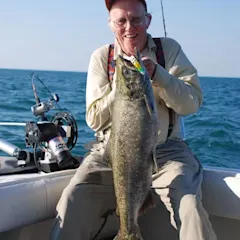Small jigs are the most versatile of all trout lures. Whether made of fur, feathers, or soft plastic, they can be fished fast or slow, shallow or deep, all according to the needs of the moment. They are extraordinarily effective in waters ranging from tiny creeks to major rivers, as well as in most trout ponds and lakes. But even though a midget jig took the world-record brown trout (see sidebar), relatively few people use them.
That’s because a cast-and-crank mentality is all too prevalent among those who tempt trout with spinning tackle
. Both spinners and spoons, the two most commonly used trout-lure types, have enough built-in action to catch at least some fish when simply reeled in after a cast. Either lure will do even better when retrieved with some finesse, but most people don’t bother.
Jigs are completely different. They have little inherent action, usually coming to life only with the rod-tip twitches you provide.
SIZE AND COLORMany effective trout jigs are actually sold as crappie lures, and the variety available is enormous. Appropriate sizes range from 1/64 to 1/8 ounce. The exact size that you need depends most on water depth and speed. In general, use the lightest jig possible that still ticks bottom as you drift and twitch it in the current. On small streams or in slower-flowing big rivers, 1/16-ounce and lighter jigs are often sufficient. In deep, fast-flowing riffles like those on the big Delaware River between New York and Pennsylvania, I need a 1/8-ounce leadhead to reach bottom.
The most common types have marabou dressing, with or without a chenille body. Soft plastics work well, too, especially tube lures from 1 to 1½ inches. Black, white, olive, and brown are the best colors. Stay away from some of the garish hues in vogue with crappie fishermen. If you tie flies (or know a friend who does), you can create jigs in outstanding patterns. A Muddler Minnow jig works great for all kinds of trout, and a Black Woolly Bugger version is just plain devastating on big rainbows.
Jig fishing tackle, meanwhile, is usually common ultra-light spinning gear. Spool up with 4-pound-test mono. Six-pound-test will turn off some wary fish, and its larger diameter makes it harder to sink. Two-pound-test is too light, and its extreme elasticity increases hooksetting difficulty. Do not use a snap or a snap-swivel, which will also spook fish.
OUT ON THE WATERWhen you’re fishing small rivers, meaning those less than about 25 feet wide, you should toss your jigs directly upstream. Cast beyond a probable trout lie such as the head of a pool or a midstream rock. Then reel just fast enough so that your jig travels downstream slightly faster than the current. As you reel, move your rod tip to steer your lure into the target zone. Add a twitch or two, and be ready. Trout tend to hit downstream-swimming baits very hard.
On bigger water, cast about 45 degrees up and across the current. Let the jig sink without retrieving. As soon as you feel the tick-tick of the bottom, tighten up by reeling, but don’t just crank it back in. Instead, twitch your rod tip intermittently, making sure that you occasionally contact the riverbed. After the jig completes its swing, reel it back and cast for another drift.
A third tactic, one that’s especially popular on Ozark tailwaters, is called the jig-and-float. In this case a very lightweight marabou jig is suspended 2 to 6 feet under a round Styrofoam bobber. The bobber should be small, roughly ½- to ¾-inch diameter. Cast the rig quartering upstream but don’t retrieve it. Instead, reel just enough to stay in contact with the bobber. Waves and ripples on the water’s surface will move the bobber up and down. This in turn wiggles the little jig hanging underneath. I once caught so many big rainbows in Arkansas’ White River that it was almost embarrassing–but I got over it.
BEAT THIS!Here is one convincing reason to use jigs for trout: The current world-record brown trout was caught on a 1/32-ounce olive marabou jig and 4-pound-test line. Howard “Rip” Collins took the 40-pound 4-ounce monster (the IGFA all-tackle record) in May 1992 while fishing the Little Red River tailwater near Heber Springs, Arkansas. Although replica mounts still exist, Collins was reportedly so proud of the fish that he had a special casket made for his trophy and was buried with it. –JOHN MERWIN


